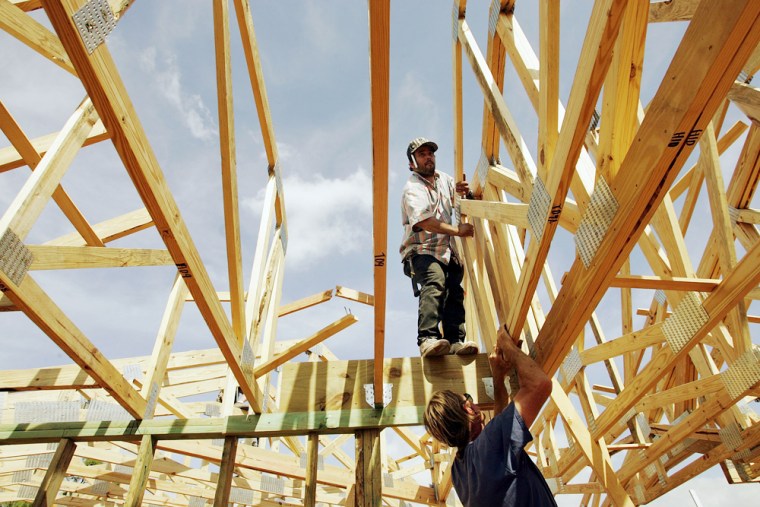A government report Friday confirmed what home buyers and sellers have been finding out recently: The once red-hot U.S. housing market is cooling off. The result is that sellers in many parts of the country have been cutting prices, and buyers are finding they have more bargaining power when they go house hunting.
Sales of new homes plunged in February, while the median price of a new home dropped for the fourth straight month, providing fresh evidence that after five years of record setting sales, the nation’s once-booming housing market is cooling off.
The Commerce Department reported that sales of new single-family homes dropped by 10.5 percent last month -- the largest amount in nearly nine years and the second straight monthly drop.
“The housing market is in a downturn, there’s no doubt about it,” said Scott J. Brown, chief economist at Raymond James & Associates. “It’s just a question of how severe.”
The answer to that question: A lot depends on where you live. In the West, where sales had been booming and prices rising rapidly, the government’s figures showed a nearly 30 percent drop in February sales from the month before. Sales in the Northeast fell nearly 13 percent. The slowdown was more modest in the Midwest and South, where sales and prices had been moving up more slowly,
With demand weakening, new home prices are also falling. The median price of a new home sold last month dropped to $230,400, down by 1.6 percent from January and 2.9 percent lower than this time last year. (The median is the mid-point where half the homes sold for more and half for less.)
The latest government data seemed to contradict a report Thursday that sales of existing homes rose by a stronger-than-expected 5.2 percent last month after falling for five straight months. The National Association of Realtors, which issued the report, said the February numbers got a one-time shot in the arm from warm weather and lower mortgage rates in January. But the longer-term trend is still downward, according to the realtors group's chief economist.
"What we have here is still the soft landing scenario we've been predicting," said NAR chief economist David Lereah. "The increase we experienced in this report is an aberration because of warm weather."
Economists said the discrepancy in the two reports may also be the result of statistical variations in the way the two reports are assembled. Sales of existing homes are reported when those sales close, while new home sales record the initial contract of sale. As a result, the report on existing homes tends to lag current market conditions, analysts said, and may not reflect the impact of the slowdown.
Seasonal adjustments to the data often overstate month-to-month changes in winter months, when the number of homes sales and pace of construction is usually slowest, analysts said.
Backlog building
As demand has fallen, and home builders have continued to put up new houses, the inventory of homes on the market has risen, putting further pressure on sellers to cut prices. The inventory of unsold homes stood at a record of 548,000 at the end of February, according to Friday’s report. That means that if sales continue at the rate recorded in February, it would take 6.3 months to sell all of the homes on the market, up from 5.3 months in January.
“There are more opportunities for buyers,” said David Seiders, chief economist for the National Association of Home Builders. “The market has been swinging from an almost absurd sellers market to a better balance supply and demand. That lets buyers take more time to bargain.”
What’s not yet clear is whether the housing slowdown is simply a return to normal from an unsustainable boom during the first half of the decade – or the start of a deeper slide. Some past real estate booms have been followed by painful declines, most recently the building spree of the late 1980s that fueled by stock market wealth and easy money lending policies for developers. The ensuing bust forced many developers into bankruptcy and helped pull the U.S. economy into a recession.
But so far, the economy isn’t flashing signs of a deeper slump, according to many analysts. A separate government report Friday showed that orders to U.S. factories for so-called durable goods rose by 2.6 percent last month, the biggest gain since November, reflected a surge in demand for commercial aircraft. Overall, orders for big-ticket manufactured goods fell by 1.3 percent, but economists said the underlying trend for manufacturing remained strong.
“The bottom line here is that industry is doing well,” said Ian Shepherdson, chief U.S. economist for High Frequency Economics.
While mortgage rates have been rising, they still remain relatively low by historical standards. The increase interests now being orchestrated by the Federal Reserve is gradual rise that should moderate the impact on housing sales, according to Seiders.
“This is not an old-style housing down cycle that’s part of an overall economic recession,” he said. “I think the chances of that are very small.”
